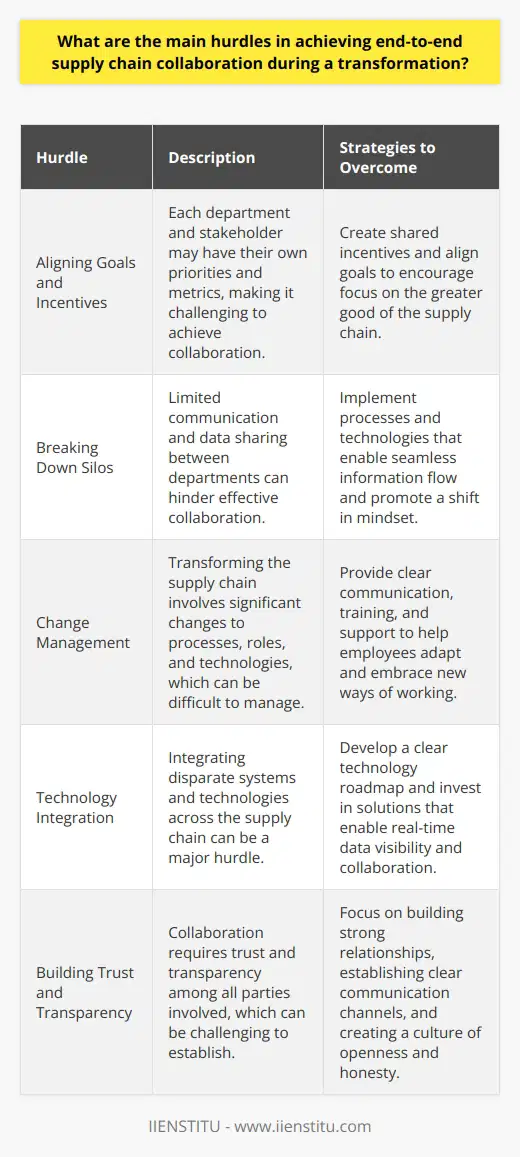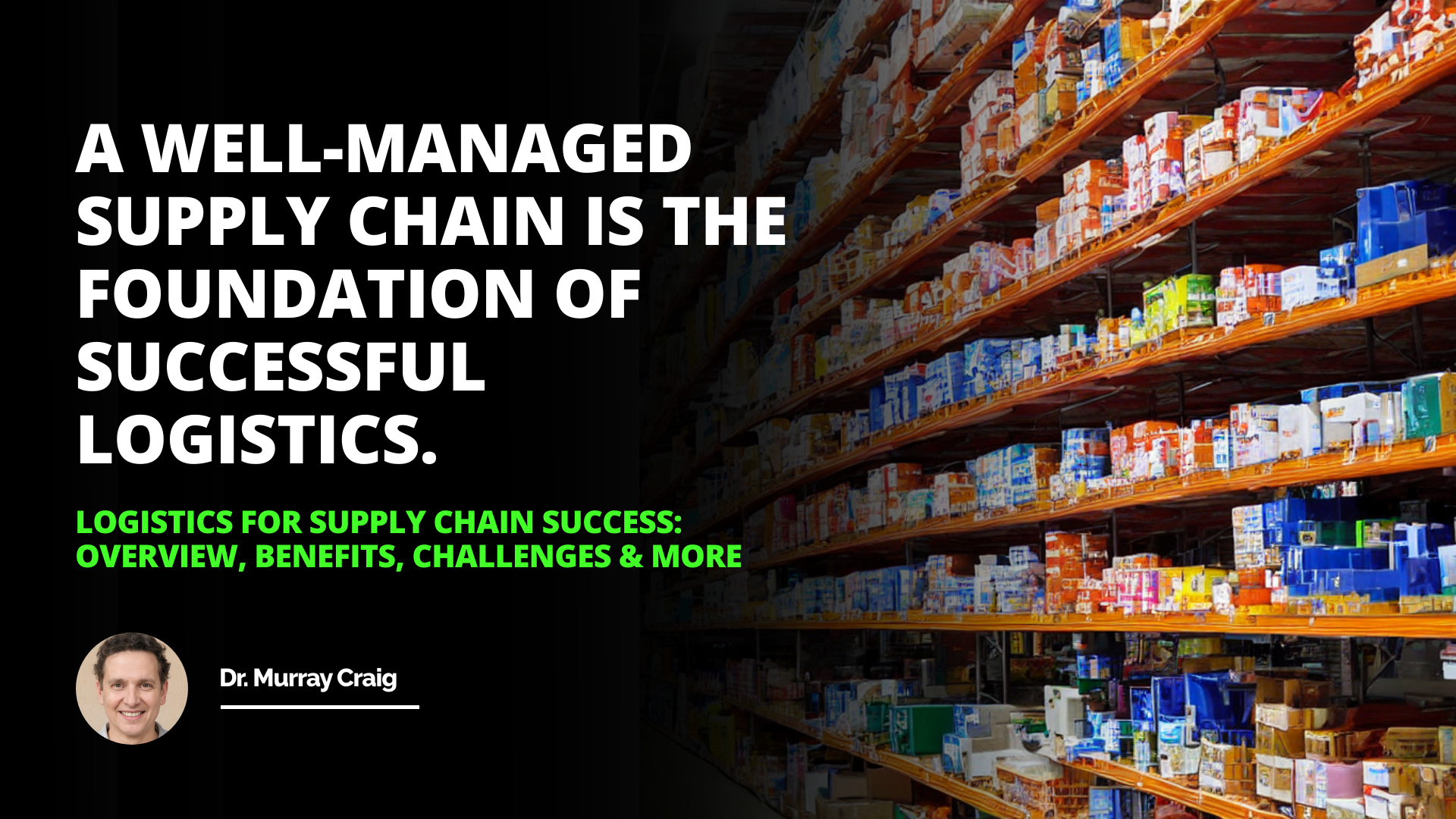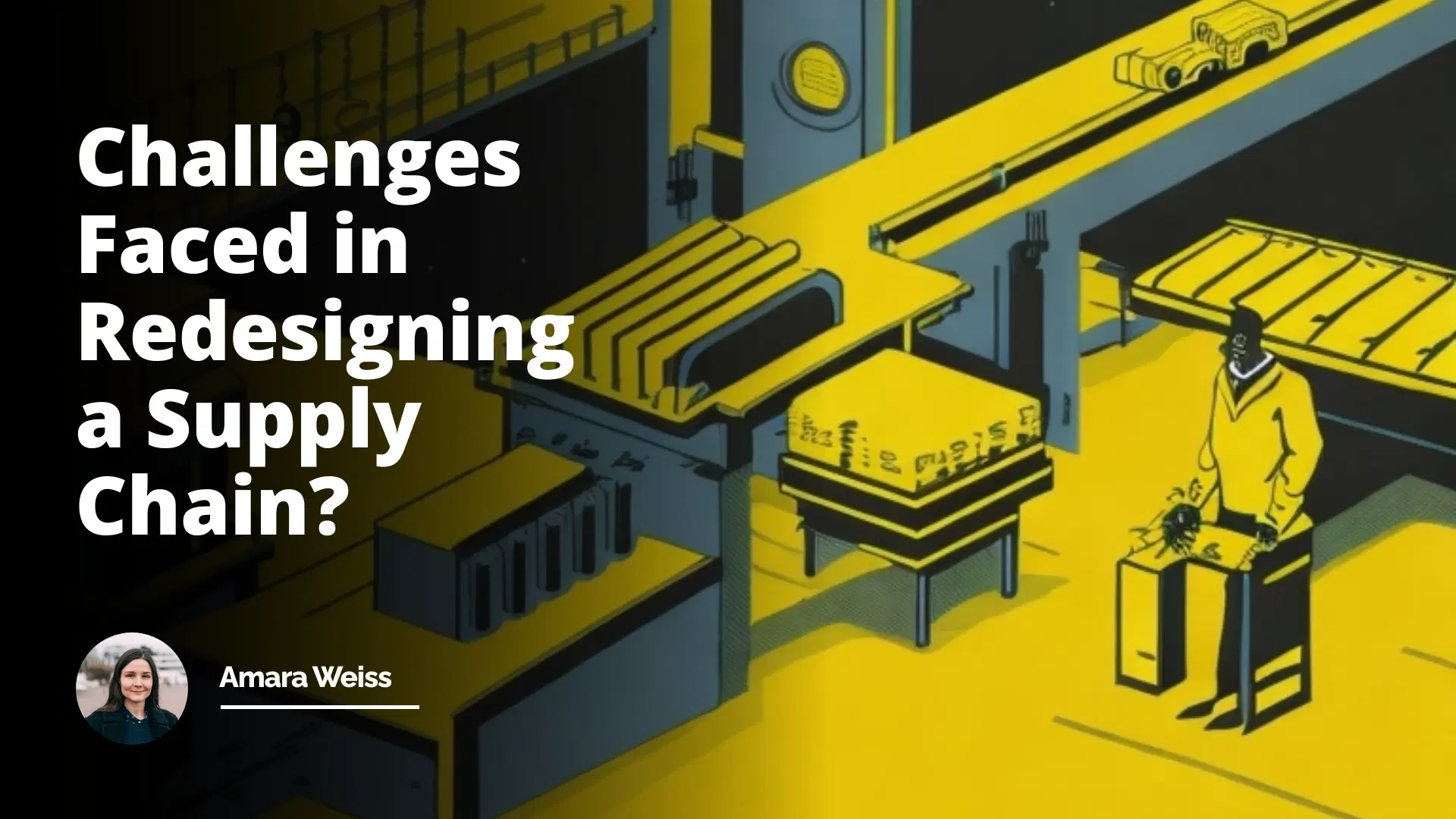
Redesigning a supply chain aren't just three words thrown together on a whim; they encompass a wide sphere of strategic planning, logistical nuances, and operational optimization.
Businesses across the globe are increasingly acknowledging the significance of efficient supply chain systems, which is leading to an increased focus on their redesign and optimization. So, let's dive right in and explore the Challenges Faced in Redesigning a Supply Chain.
Why is the Question asked in an Interview: What are the Challenges Faced in Redesigning a Supply Chain?
To begin with, the question - "What are the challenges faced in redesigning a supply chain?" - is typically asked in interviews for roles subjected to managing, planning, or strategizing the supply chain dynamics in an organization.
This question captures the essence of the hardships and obstacles that a candidate is likely to encounter while dealing with supply chain operations.
When interviewers ask this question, they are assessing your practical understanding, and more importantly, your problem-solving abilities. In other words, they're sizing up whether you can stay afloat when the waters of supply chain management get choppy.
The Purpose of the Question
The main aim behind asking this question is to determine your knowledge of the field and your ability to anticipate, navigate, and resolve the potential hurdles in a supply chain redesign process.
In essence, your response will provide the interviewer with insights into your pragmatic experience, prescient thinking, and your skill in transforming complex issues into manageable tasks.
At what Interview Level is it Asked?
This idea-provoking question especially features in interviews for mid to senior-level roles, although entry-level candidates with a background in supply chain management or logistics might also face this question. At these levels, a strong understanding of supply chain mechanics is essentially a prerequisite.
The interviewer expects candidates to not only understand the theoretical aspects, but also possess enough practical exposure to identify potential hurdles and suggest action plans to mitigate them.
What Kind of Answer is Expected from the Candidate?
As a candidate, it's imperative to provide a multidimensional response to this question. The answer should include an overview of why supply chain redesign becomes necessary, followed by a comprehensive explication of atypical challenges one might face in this process, such as planning and implementing changes, managing risks, and ensuring seamless transition without disrupting service.
Remember, a good answer will not merely list out some challenges. Rather, it would elucidate your experiences in tackling those challenges, displaying your suitability for the role in question.
Possible Answers to Consider
Let's consider an appropriate answer for the question. You might begin by highlighting that the redesign process involves various challenges, from managing costs to ensuring minimal disruption. Simultaneously, these challenges are also opportunities to streamline processes and foster operational efficiencies.
For instance, you might say,
"One major challenge is the resistance to change. Employees used to a specific way of working may find a redesigned supply chain difficult to navigate initially. To cope with this, change management methodologies can be used, such as clear communication strategies, training programs, and support systems for employees."
Another point you could raise is about managing cost while ensuring efficiency:
"Redesigning a supply chain might require significant upfront investment. It is essential to strike a balance between cost optimization and efficiency. This can be tackled by extensive market research, thorough planning, and phased implementation."
In conclusion, the complexities associated with redesigning a supply chain make it a challenging yet rewarding venture. To successfully navigate this process, understanding the potential pitfalls, coupled with robust risk-mitigation strategies, is pivotal.
Remember, a well-designed supply chain could substantially amplify your company's growth trajectory and competitiveness in today's dynamic market. So, when the question about challenges in redesigning a supply chain pops up in your next interview, you'll know exactly what to say!
Table 1: Impacts of Technological Integration on Supply Chain Redesign
Table 2: Strategies for Addressing Challenges Faced in Redesigning a Supply Chain
Table 3: Risk Management Challenges in Supply Chain Redesign
Similar interview questions:
What are the main difficulties encountered when reorganizing a supply chain?
Can you list the obstacles that one may come across while trying to redesign a supply chain?
What potential issues might one confront when attempting to restructure a supply chain?
Are there any specific challenges associated with modifying a supply chain's design?
Could you discuss the challenges that might occur during the process of redesigning a supply chain?
What problems are commonly faced during the redesigning of a supply chain?
What hindrances would you anticipate in the process of a supply chain redesign?
Could you detail the complications that might arise when attempting to overhaul a supply chain?
In your experience, what struggles are typically encountered when reengineering a supply chain?
Can you give an overview of typical problems that can emerge during the restructuring of a supply chain?
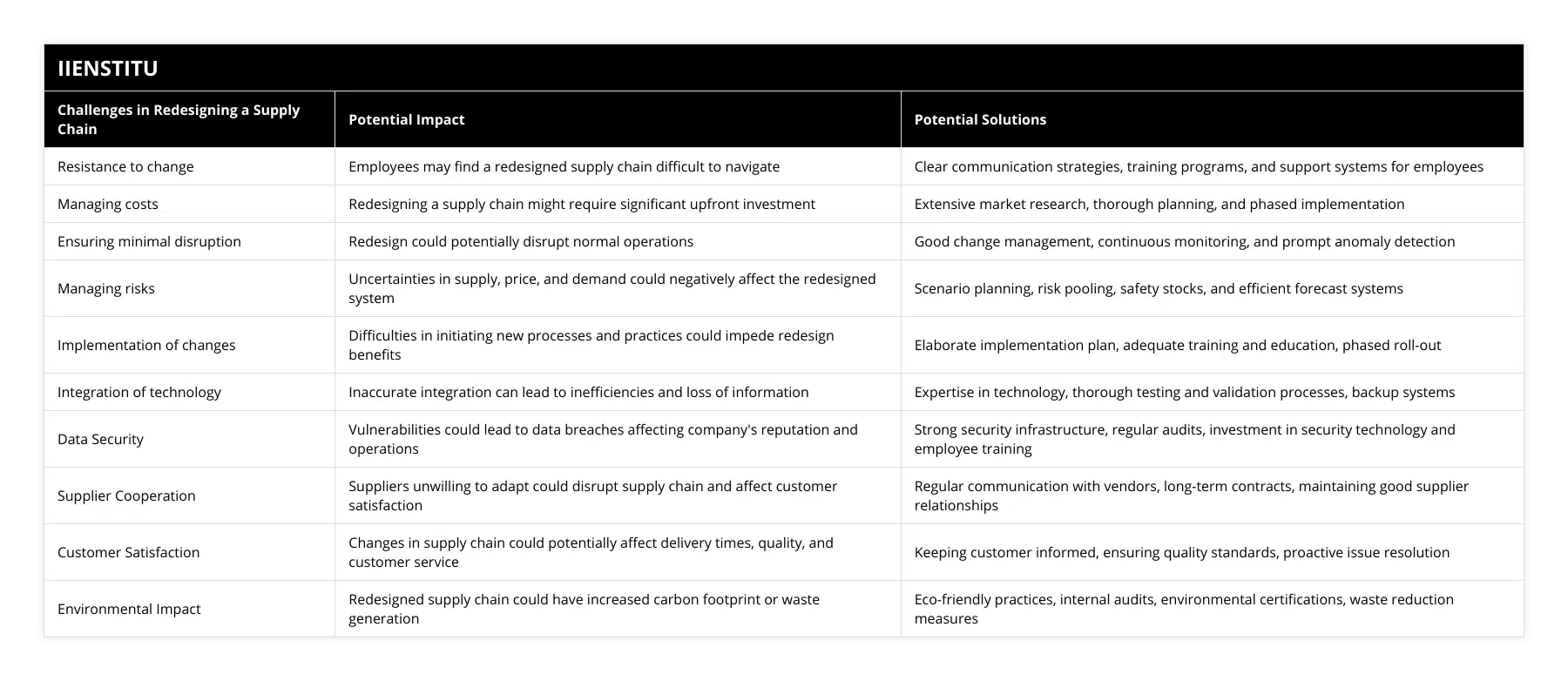
Frequently Asked Questions
What are the major obstacles in restructuring a supply chain?
Restructuring a supply chain can be a complex and challenging process. Several major obstacles can arise during this undertaking.
Resistance to Change
One of the biggest hurdles is often the resistance to change within the organization. People may be comfortable with the existing processes and reluctant to adopt new ways of working. Overcoming this resistance requires clear communication, training, and support from leadership.
Integration Challenges
Integrating new systems, technologies, and processes can be difficult. Compatibility issues, data migration, and ensuring seamless connectivity between different parts of the supply chain can be time-consuming and resource-intensive. It's crucial to have a well-planned implementation strategy and experienced teams to handle these technical aspects.
Coordination and Collaboration
Supply chain restructuring often involves multiple stakeholders, both internal and external. Coordinating efforts and fostering collaboration among various departments, suppliers, and partners can be challenging. Clear roles, responsibilities, and open lines of communication are essential for success.
Cost and Resource Constraints
Restructuring initiatives often come with significant costs and limited resources. Balancing the investment in new technologies, infrastructure, and talent with the need to maintain ongoing operations can be a delicate act. Careful budgeting, prioritization, and phased implementation can help manage these constraints effectively.
Change Management
Managing change throughout the restructuring process is critical. Employees need to be trained on new processes, and customers and partners need to be informed about any changes that may affect them. A robust change management plan, including communication strategies and support mechanisms, is vital for a smooth transition.
In my experience, when my company underwent a supply chain restructuring a few years ago, we faced many of these challenges firsthand. It was a learning experience that taught us the importance of planning, communication, and adaptability. While the obstacles can seem daunting, with the right approach and mindset, restructuring a supply chain can lead to significant improvements in efficiency, agility, and overall business performance.
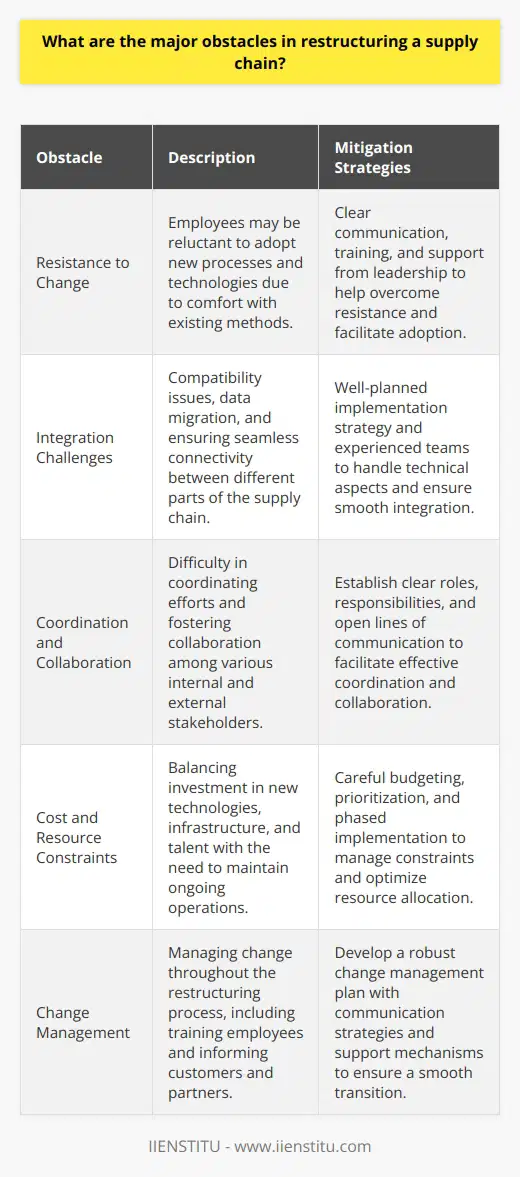
What are the common pitfalls to avoid when redesigning a supply chain?
When redesigning a supply chain, there are several common pitfalls that you should be aware of and avoid.
Focusing Too Much on Cost Reduction
While reducing costs is important, it shouldn't be the sole focus of your supply chain redesign efforts. I once worked on a project where we cut costs so much that product quality suffered, and we lost customers as a result. It's crucial to strike a balance between efficiency and effectiveness.
Neglecting Risk Management
Supply chains are vulnerable to various risks, such as natural disasters, political instability, and supplier bankruptcies. In my experience, companies that fail to identify and mitigate these risks often face significant disruptions when unexpected events occur. Incorporating risk management into your redesign process is essential for building a resilient supply chain.
Overlooking the Importance of Collaboration
Redesigning a supply chain is a complex undertaking that requires collaboration across different functions and organizations. I've seen projects fall apart because of a lack of communication and alignment among stakeholders. To avoid this pitfall, make sure to involve all relevant parties early on and foster a culture of openness and teamwork.
Underestimating the Complexity of Implementation
Implementing a redesigned supply chain can be a daunting task, especially if you underestimate the complexity involved. I remember a company that tried to switch to a new inventory management system without proper planning and training, which resulted in chaos and lost sales. To ensure a smooth transition, break down the implementation into manageable phases and allocate sufficient resources.
Failing to Measure and Monitor Performance
Finally, don't forget to establish clear performance metrics and regularly monitor your redesigned supply chain. Without data-driven insights, it's impossible to know whether your efforts are paying off and where further improvements are needed. In my past roles, I've always made sure to set up dashboards and review sessions to keep everyone informed and aligned.
By avoiding these common pitfalls and taking a holistic approach, you can successfully redesign your supply chain for improved efficiency, resilience, and customer satisfaction.
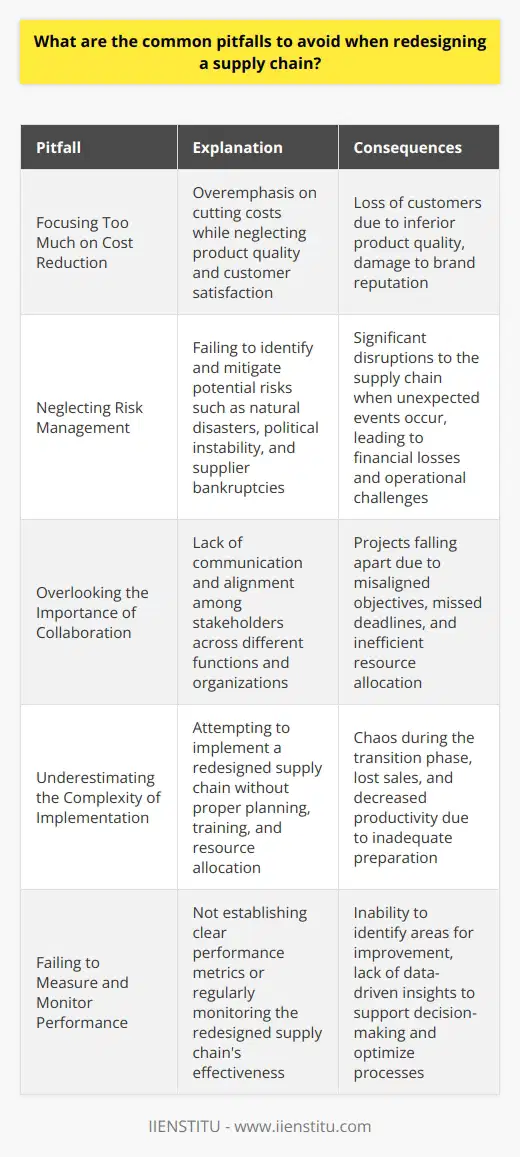
How can a company effectively manage the risks associated with supply chain redesign?
When it comes to managing risks associated with supply chain redesign, a company must take a proactive approach. They need to identify potential risks early on and develop strategies to mitigate them. This requires close collaboration between different departments within the organization, such as procurement, logistics, and finance.
Conduct a thorough risk assessment
The first step is to conduct a comprehensive risk assessment of the entire supply chain. This involves analyzing each stage of the process, from sourcing raw materials to delivering finished products to customers. By identifying potential weak points and vulnerabilities, the company can prioritize areas that require immediate attention.
Develop contingency plans
Once risks have been identified, the next step is to develop contingency plans. These are alternative courses of action that can be implemented quickly if something goes wrong. For example, if a key supplier fails to deliver on time, the company should have a backup supplier lined up to avoid disruptions.
Foster strong supplier relationships
Another critical aspect of managing supply chain risks is building strong relationships with suppliers. This means regularly communicating with them, sharing information, and working together to solve problems. By establishing trust and transparency, the company can reduce the likelihood of unexpected issues arising.
Embrace technology and automation
Finally, embracing technology and automation can help streamline supply chain processes and reduce risks. For instance, using real-time tracking systems can provide visibility into the movement of goods, allowing the company to quickly identify and resolve any delays or disruptions.
In my experience, I've seen firsthand how a well-managed supply chain can be a significant competitive advantage. It's not always easy, but by being proactive and staying vigilant, companies can minimize risks and ensure a smooth flow of goods from start to finish.
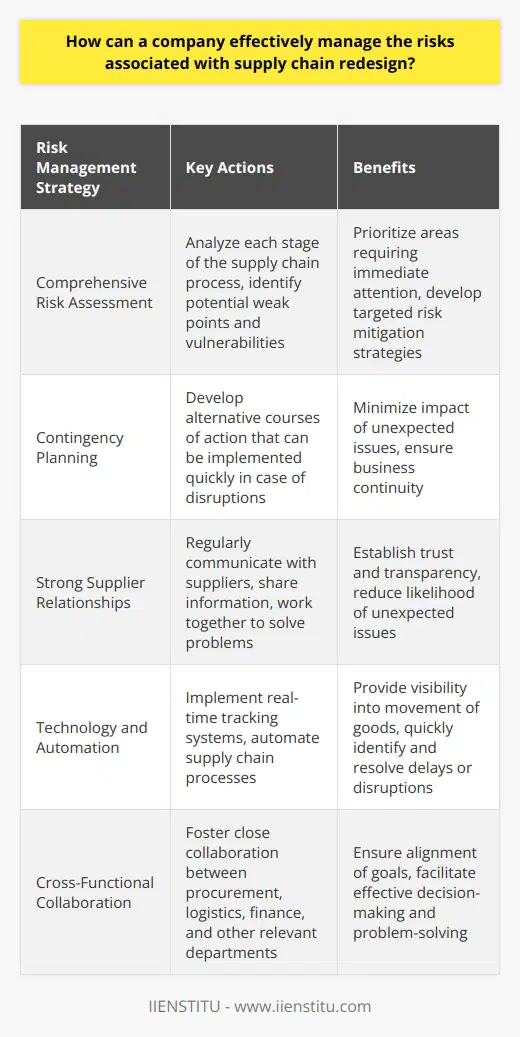
What are the key considerations when revamping a supply chain?
When revamping a supply chain, there are several key considerations to keep in mind. First and foremost, you need to thoroughly analyze your current supply chain processes to identify areas for improvement. This involves mapping out the entire supply chain from sourcing raw materials to delivering finished products to customers.
Streamlining Processes
Once you've identified inefficiencies, you can start streamlining processes. This might involve consolidating suppliers, optimizing inventory levels, or implementing new technologies like automation and data analytics. The goal is to reduce waste, minimize costs, and improve overall efficiency.
Collaborating with Partners
Another critical aspect of revamping a supply chain is collaborating closely with partners. This includes suppliers, manufacturers, distributors, and even customers. By fostering open communication and shared goals, you can create a more agile and responsive supply chain that can quickly adapt to changing market conditions.
Embracing Technology
In today's digital age, embracing technology is essential for supply chain success. Tools like cloud computing, IoT sensors, and blockchain can provide real-time visibility into supply chain operations, enabling faster decision-making and greater transparency. By leveraging these technologies, you can create a more intelligent and connected supply chain.
Focusing on Sustainability
Finally, it's important to consider sustainability when revamping a supply chain. This means minimizing the environmental impact of your operations, such as reducing carbon emissions and waste. It also involves ensuring ethical sourcing practices and fair labor conditions throughout the supply chain. By prioritizing sustainability, you can not only improve your company's reputation but also create long-term value for all stakeholders.
In my experience, revamping a supply chain is a complex and challenging process that requires careful planning and execution. But by keeping these key considerations in mind and staying adaptable, you can create a more efficient, responsive, and sustainable supply chain that drives business success.
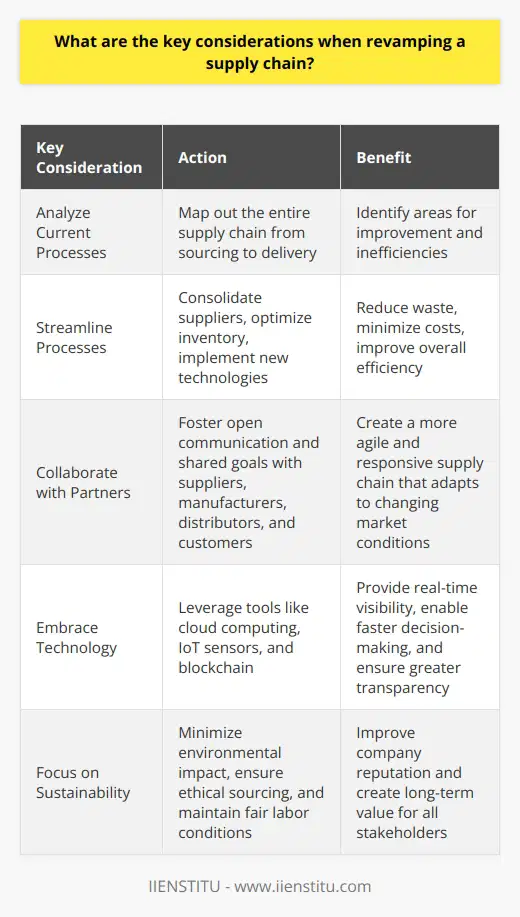
How can a business ensure a smooth transition during a supply chain overhaul?
To ensure a smooth transition during a supply chain overhaul, a business must prioritize clear communication and collaboration. In my experience, establishing open lines of communication between all stakeholders is essential.
Develop a Comprehensive Plan
Before initiating the overhaul, create a detailed plan that outlines the goals, timeline, and responsibilities of each team member. This plan should be flexible enough to accommodate unforeseen challenges that may arise during the transition.
Involve All Stakeholders
Engage all stakeholders, including suppliers, logistics partners, and internal departments, in the planning process. Their insights and expertise can help identify potential roadblocks and develop effective solutions.
Implement Change Gradually
Avoid the temptation to overhaul the entire supply chain at once. Instead, implement changes gradually to minimize disruptions. Start with a pilot project to test new processes and technologies before rolling them out across the organization.
Monitor Progress Closely
Throughout the transition, closely monitor key performance indicators to identify areas that need improvement. Be prepared to make adjustments as needed to ensure the overhaul stays on track.
Provide Training and Support
Offer comprehensive training and support to employees affected by the supply chain overhaul. This will help them adapt to new processes and technologies more quickly and effectively.
Remember, a successful supply chain transition requires patience, adaptability, and a willingness to learn from mistakes. By focusing on these key areas, a business can minimize disruptions and emerge with a more efficient and resilient supply chain.
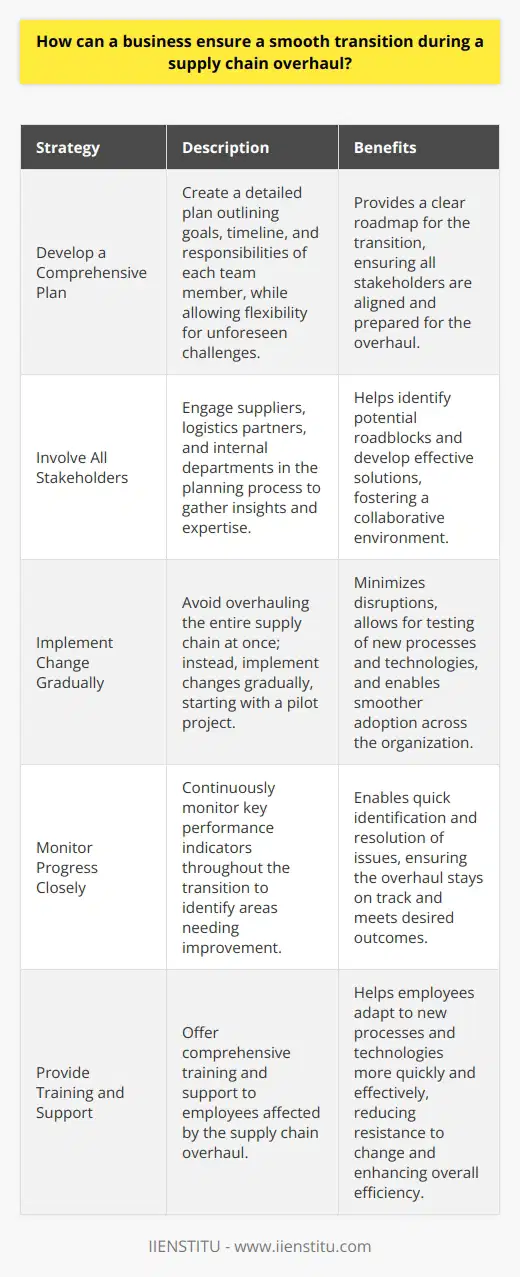
What are the most significant hurdles in optimizing a supply chain?
As someone who has worked in supply chain management for over a decade, I can confidently say that there are several significant hurdles in optimizing a supply chain. One of the biggest challenges is aligning all stakeholders towards a common goal.
Aligning Stakeholders
Each department often has its own priorities and metrics, which can clash with others. For instance, procurement may focus on cost reduction while sales prioritizes quick delivery times. Finding a balance that satisfies everyone is tricky but crucial.
Managing Complexity
Another hurdle is managing the sheer complexity of modern supply chains. With globalization, there are countless moving parts spread across different countries and time zones. Keeping track of everything and making sure it runs smoothly is a mammoth task that requires constant vigilance.
Adapting to Change
Supply chains also need to be adaptable to change, whether it's shifting consumer demands, new regulations, or unexpected disruptions like natural disasters. Having contingency plans and being able to pivot quickly is essential but not always easy.
Leveraging Technology
Finally, there's the challenge of leveraging technology effectively. While tools like AI and blockchain offer immense potential for optimization, implementing them is often difficult due to legacy systems and resistance to change. Overcoming these barriers requires a strategic approach and buy-in from all levels of the organization.
In my experience, the key to tackling these hurdles is open communication, flexibility, and a willingness to experiment. It's not always a smooth journey, but with the right mindset and tools, supply chain optimization is achievable.

How can an organization mitigate the challenges of supply chain transformation?
To mitigate the challenges of supply chain transformation, an organization must first identify its current pain points. This involves analyzing data, gathering feedback from stakeholders, and conducting thorough assessments of existing processes.
Develop a Clear Strategy
Once the challenges are identified, it's crucial to develop a clear strategy aligned with the organization's goals. The strategy should outline specific objectives, timelines, and metrics for measuring success. It's important to involve key stakeholders in the strategy development process to ensure buy-in and support.
Invest in Technology
Investing in the right technology is essential for successful supply chain transformation. When I worked at my previous company, we implemented a cloud-based supply chain management system that significantly improved our visibility and efficiency. It allowed us to track inventory levels in real-time, automate processes, and collaborate more effectively with our suppliers.
Foster Collaboration and Communication
Effective collaboration and communication are critical for mitigating supply chain challenges. Organizations should establish clear channels for cross-functional communication and encourage teamwork. I've found that regular meetings, shared dashboards, and collaborative tools like Slack can help break down silos and improve coordination.
Continuously Monitor and Optimize
Supply chain transformation is an ongoing process that requires continuous monitoring and optimization. Organizations should regularly review their metrics, identify areas for improvement, and adapt their strategies as needed. It's important to celebrate successes along the way and learn from any setbacks.
In my experience, successful supply chain transformation requires a combination of strategic planning, technological investment, and effective collaboration. By taking a proactive approach and continuously improving, organizations can overcome challenges and achieve their supply chain goals.
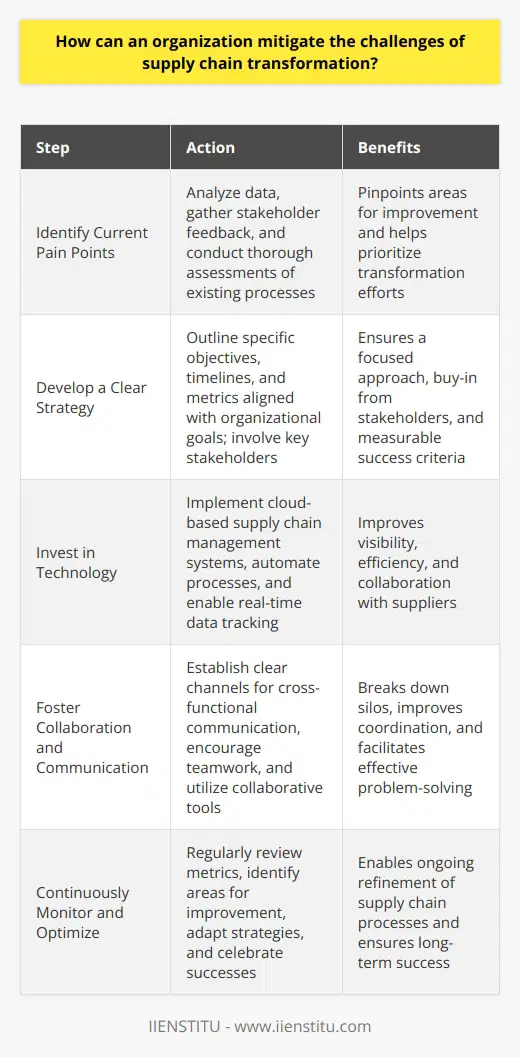
What are the critical success factors in supply chain redesign?
When redesigning a supply chain, several critical success factors come into play. First and foremost, you need to have a clear understanding of your company's strategic objectives. What are you trying to achieve? Is it cost reduction, improved customer service, or something else entirely?
Collaboration and Communication
Effective collaboration and communication among all stakeholders is essential. This includes internal departments like procurement, logistics, and sales, as well as external partners such as suppliers and customers. Everyone needs to be on the same page and working towards common goals.
Data-Driven Decision Making
Making data-driven decisions is crucial. You need to have accurate, real-time data on inventory levels, demand forecasts, and transportation costs. This information will help you identify bottlenecks and opportunities for improvement.
Flexibility and Adaptability
In today's fast-paced business environment, flexibility and adaptability are key. Your supply chain needs to be agile enough to respond quickly to changes in demand or disruptions in the supply chain. This may require investing in new technologies or processes.
Continuous Improvement
Finally, a successful supply chain redesign is not a one-time event. It's an ongoing process of continuous improvement. You need to regularly monitor performance metrics and make adjustments as needed. By staying focused on these critical success factors, you can create a supply chain that is efficient, responsive, and aligned with your company's overall strategy.
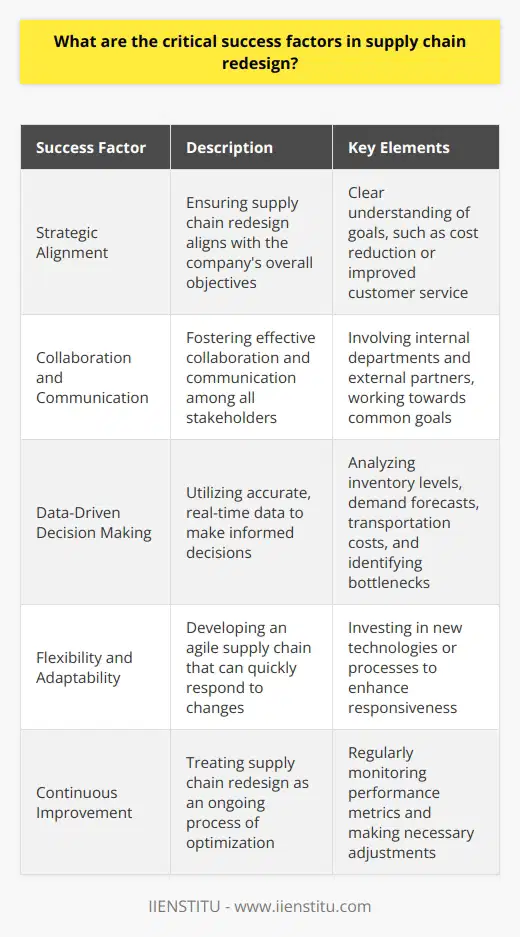
How can a company navigate the complexities of supply chain restructuring?
I once led a project to restructure our company's supply chain in response to changing market conditions. It was a complex undertaking with many moving parts. Here are a few key things I learned:
Start With a Clear Plan and Objectives
We developed a detailed project plan outlining goals, responsibilities, milestones, and success metrics. Having this roadmap kept us focused and aligned.
Analyze Data to Inform Decisions
Gathering and analyzing data on supplier performance, logistics, costs, and risks provided crucial insights. Data helped us make objective, fact-based decisions rather than relying on hunches.
Collaborate With Stakeholders
No one has all the answers. We worked closely with internal teams and external partners to get input and buy-in. Collaboration was essential for developing optimal solutions.
Identify Quick Wins But Plan Long-Term
We prioritized initiatives that delivered fast results to build momentum. But we also kept the long-term vision in mind and invested in foundational improvements.
Stay Agile and Adaptable
Supply chains are dynamic. Unexpected issues will arise. The key is building agility into your processes. Be ready to pivot when needed to keep things on track.
Those are some of my key takeaways from leading that complex project. Of course, every situation is unique. But I believe those principles of planning, collaboration, adaptability, and balancing quick wins with a long-term outlook are crucial for navigating supply chain transformations successfully.
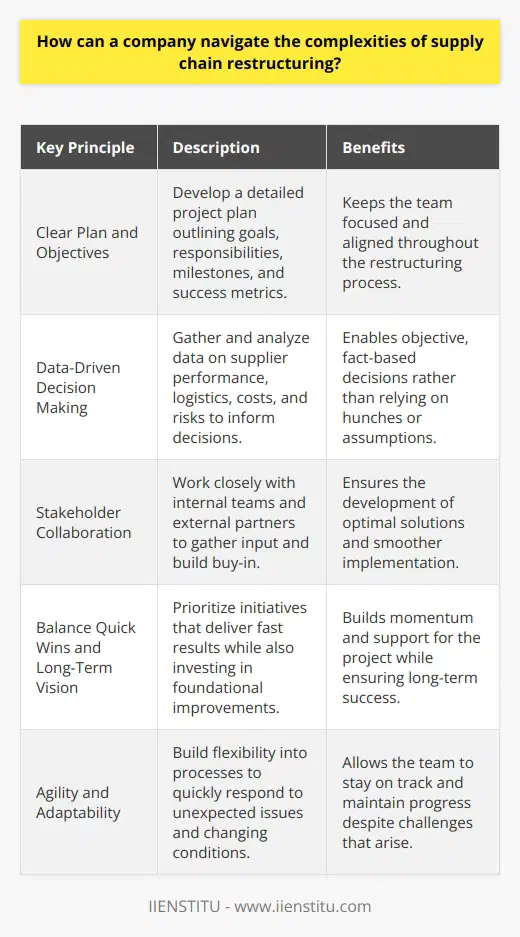
What are the potential disruptions that may arise during a supply chain revamp?
When undergoing a supply chain revamp, several potential disruptions may arise. Here are some examples from my experience:
Resistance to Change
Employees and partners may resist new processes and technologies. I once saw a company struggle to implement a new inventory management system because workers were comfortable with the old way of doing things.
Integration Issues
Integrating new systems with existing ones can cause technical glitches and delays. In my previous role, we faced compatibility problems when connecting our new tracking software to our legacy databases.
Supplier Challenges
Changes in procurement processes or supplier relationships can lead to supply interruptions. I remember a case where a key supplier couldn't meet the new quality standards, causing production delays.
Training and Adoption
Inadequate training on new procedures and tools can hinder adoption and efficiency. When my team rolled out a new logistics platform, some staff struggled to adapt, impacting our shipping timelines.
Unexpected External Factors
External events like natural disasters, geopolitical issues, or market shifts can disrupt even the best-laid plans. I once witnessed a supply chain revamp derailed by a sudden raw material shortage.
While these disruptions can be challenging, proactive planning, clear communication, and flexibility can help mitigate their impact. In my experience, having contingency plans and fostering a culture of adaptability are key to navigating supply chain transformations successfully.
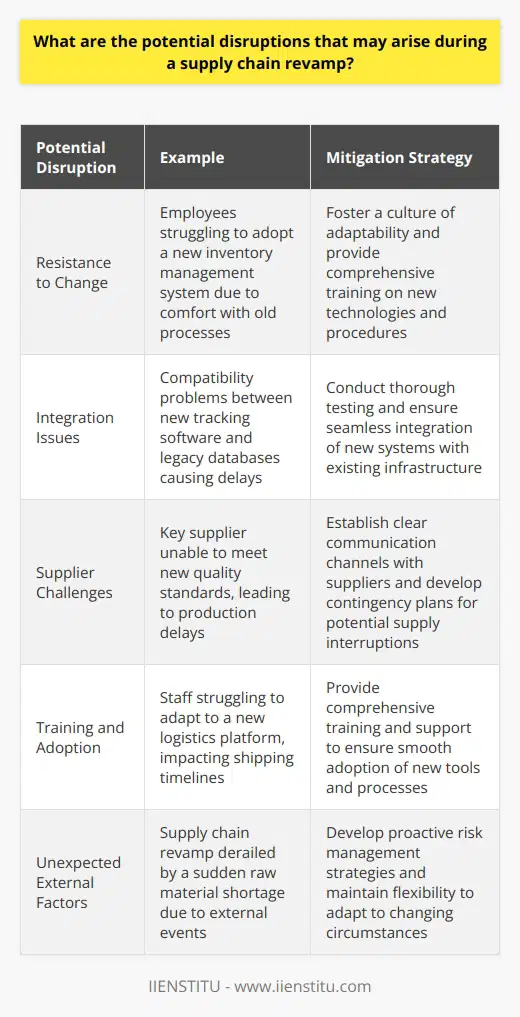
How can a business maintain continuity during a supply chain redesign process?
Maintaining business continuity during a supply chain redesign requires careful planning and execution. I've personally been involved in several such projects, and I can tell you from experience that communication is key. You need to keep all stakeholders informed about the changes and how they will be implemented.
Develop a Comprehensive Plan
Before starting the redesign process, develop a detailed plan that outlines the steps involved and the timeline. This plan should include contingencies for potential disruptions and identify critical suppliers and customers who may be impacted.
Prioritize Critical Components
Identify the most critical components of your supply chain and prioritize them in your redesign efforts. This ensures that essential operations continue without interruption.
Maintain Open Communication
Throughout the redesign process, maintain open lines of communication with suppliers, customers, and internal teams. Regularly update them on progress and address any concerns they may have.
Collaborate with Key Partners
Work closely with key suppliers and logistics partners to ensure a smooth transition. Their expertise and support can be invaluable in minimizing disruptions.
Implement Changes Gradually
Implement changes gradually rather than all at once. This allows you to test new processes and make adjustments as needed without causing major disruptions.
Monitor and Adjust
Continuously monitor the redesigned supply chain and be prepared to make adjustments as necessary. Having a flexible and adaptable approach is crucial for maintaining continuity.
In my experience, following these steps has helped ensure successful supply chain redesigns while minimizing disruptions to the business. It's not always easy, but with careful planning and execution, it can be done.
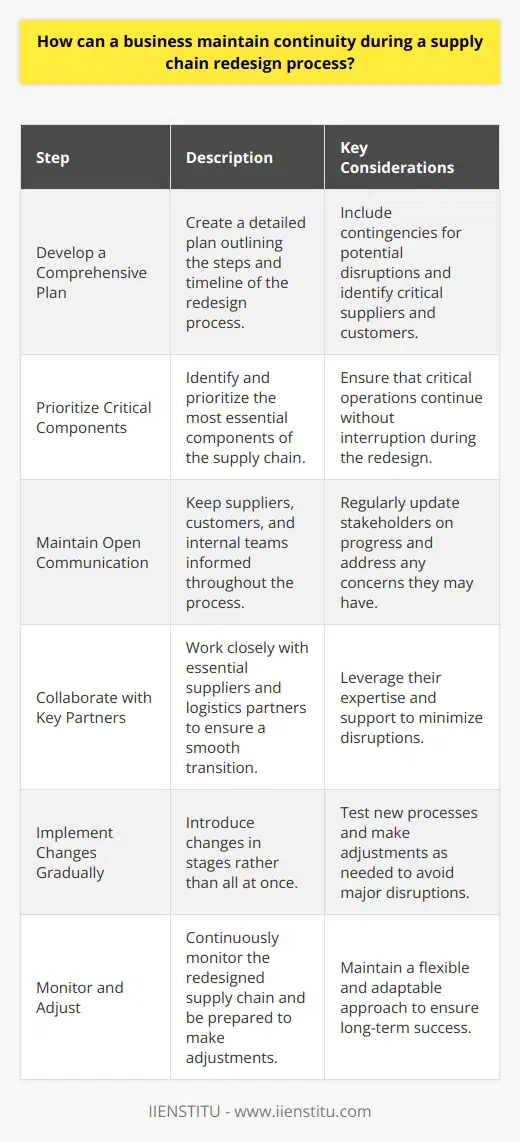
What are the main challenges in aligning supply chain redesign with overall business strategy?
Aligning supply chain redesign with overall business strategy presents several challenges. One major hurdle is ensuring seamless communication and collaboration between different departments within the organization. Without effective cross-functional teamwork, it becomes difficult to develop a cohesive supply chain strategy that supports the company's goals.
Balancing Competing Priorities
Another challenge lies in balancing competing priorities, such as reducing costs while maintaining high quality and customer satisfaction. It's crucial to find the right balance and make trade-offs that align with the overall business objectives. This requires careful analysis and decision-making to ensure the supply chain redesign doesn't compromise other critical aspects of the business.
Adapting to Changing Market Conditions
Moreover, the dynamic nature of today's markets demands agility and adaptability in supply chain management. Businesses must be prepared to quickly adjust their supply chain strategies in response to changing customer preferences, technological advancements, and global economic shifts. Failing to adapt can lead to missed opportunities and a loss of competitive advantage.
Overcoming Resistance to Change
Implementing a supply chain redesign often involves significant changes to existing processes, systems, and organizational structure. Overcoming resistance to change from employees and stakeholders can be a daunting task. It requires effective change management, clear communication, and strong leadership to ensure everyone is on board and committed to the new strategy.
Measuring and Monitoring Performance
Finally, measuring and monitoring the performance of the redesigned supply chain is essential to ensure it aligns with business objectives. Establishing key performance indicators (KPIs) and regularly tracking progress helps identify areas for improvement and enables timely adjustments to keep the supply chain on track.
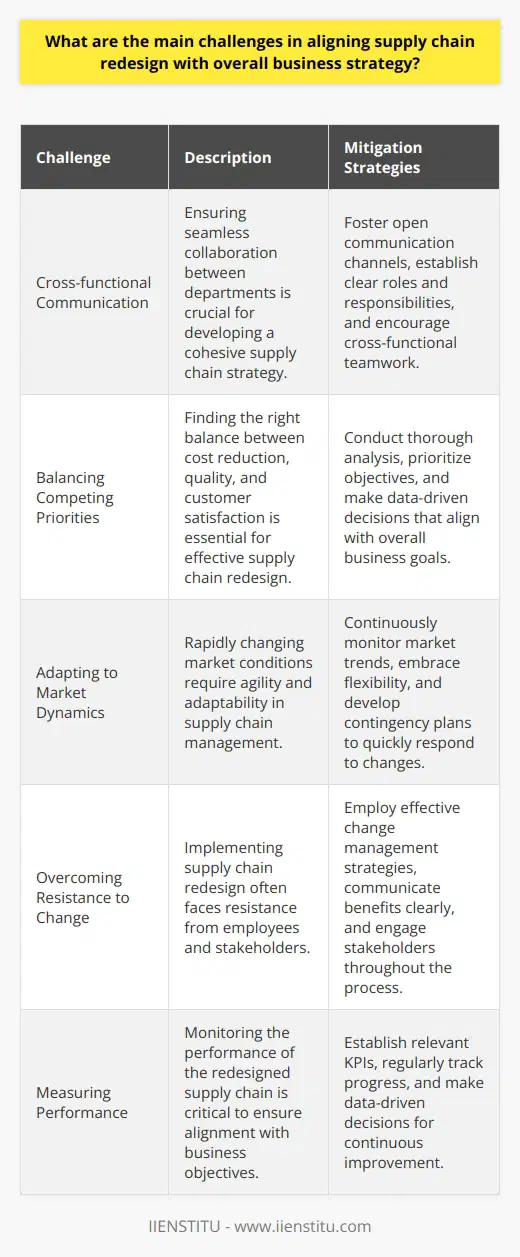
How can an organization effectively communicate changes during a supply chain overhaul?
Effective communication is key when an organization is undergoing a supply chain overhaul. I've found that a multi-faceted approach works best.
Develop a Clear Communication Plan
Before making any changes, create a detailed communication plan. This should include the what, why, when, and how of the overhaul. Make sure to involve key stakeholders in the planning process.
Use Multiple Communication Channels
Don't rely on just one method of communication. Use a variety of channels like email, meetings, and internal newsletters. This ensures the message reaches everyone and accommodates different communication preferences.
Be Transparent and Honest
Be upfront about the reasons for the changes and the expected impact. Don't sugarcoat potential challenges. Employees appreciate honesty and are more likely to get on board when they understand the full picture.
Provide Regular Updates
Keep employees informed throughout the process with frequent updates. Share progress, successes, and any adjustments to the plan. This helps maintain momentum and shows that their efforts are making a difference.
Encourage Two-Way Communication
Create opportunities for employees to ask questions, share concerns, and offer suggestions. Listen actively and address their feedback. When people feel heard, they're more invested in the changes.
Celebrate Milestones and Successes
Recognize and reward employees' hard work during the transition. Celebrating wins, big and small, boosts morale and motivation.
In my experience, following these strategies leads to smoother implementations and better outcomes. It takes effort, but effective communication is always worth the investment.

What are the key metrics to monitor during a supply chain transformation?
When monitoring a supply chain transformation, I focus on three key metrics. First, I track inventory levels and turnover rates. This helps me ensure we have the right products in stock without tying up too much capital. Reducing excess inventory while maintaining service levels is critical.
Second, I closely watch lead times and on-time delivery percentages. Streamlining processes to shorten lead times allows us to be more responsive to customer needs. And of course, consistently delivering orders on-schedule is essential for keeping clients happy. Even small improvements in these areas can give us an edge.
Optimizing Costs and Efficiency
Finally, I always keep an eye on overall supply chain costs and efficiency ratios. Transformation initiatives should ultimately result in leaner operations and cost savings. I dive into the details of transportation spend, warehousing costs, labor productivity and more. Comparing these numbers against industry benchmarks reveals improvement opportunities.
While KPIs will vary by company, in my experience, inventory, speed, and cost are the core supply chain transformation metrics to track. Getting these fundamentals right sets the foundation for continuous improvement and business success. It's challenging work, but I find it incredibly rewarding to optimize supply chains and boost bottom-line results.
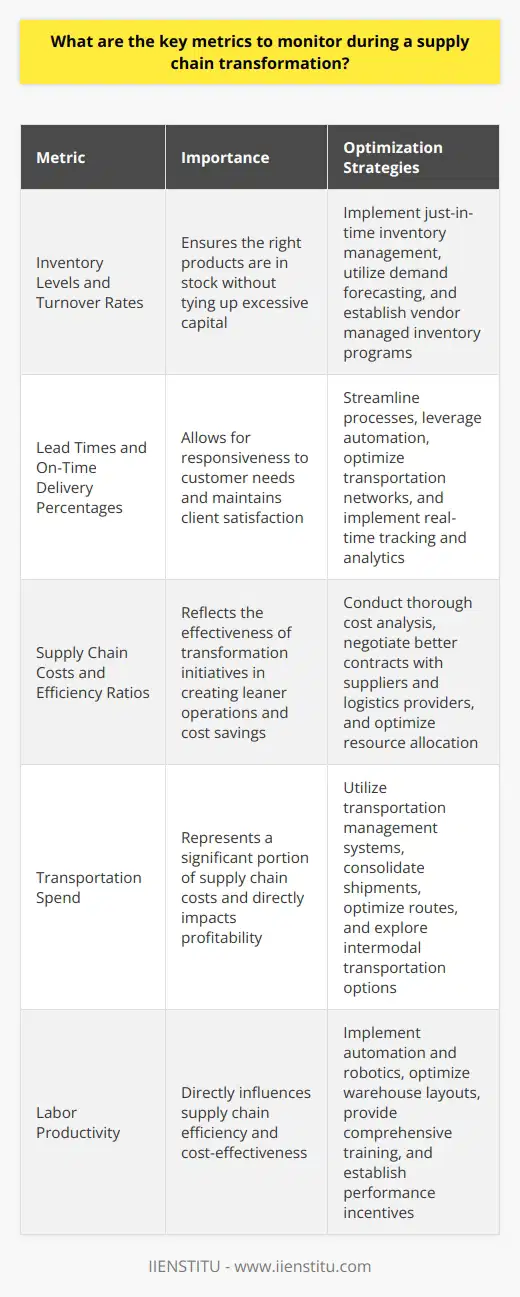
How can a company manage stakeholder expectations during a supply chain redesign?
Managing stakeholder expectations during a supply chain redesign is a critical aspect of ensuring project success. I've found that effective communication is key to keeping everyone informed and aligned. Here are some strategies that have worked well for me in the past:
Identify and Prioritize Stakeholders
The first step is to identify all relevant stakeholders and understand their interests and concerns. I create a stakeholder map to visualize the relationships and prioritize based on influence and impact.
Develop a Clear Communication Plan
Once I know who the key stakeholders are, I develop a targeted communication plan. This includes regular updates, status reports, and face-to-face meetings. I aim to be transparent about progress, challenges, and any changes in scope or timeline.
Set Realistic Expectations
It's important to be upfront about what the redesign can and cannot achieve. I work with stakeholders to define clear, measurable goals and KPIs. If there are constraints or trade-offs, I discuss these openly to avoid surprises down the line.
Involve Stakeholders in Decision-Making
Engaging stakeholders in key decisions helps build buy-in and ownership. I set up workshops and feedback sessions to gather input and ideas. This collaborative approach often leads to better solutions and smoother implementation.
Monitor and Adapt
Throughout the redesign process, I closely monitor stakeholder sentiment and feedback. If issues or concerns arise, I address them promptly. Being responsive and adaptable helps maintain trust and confidence in the project.
In my experience, proactively managing stakeholder expectations is essential for a successful supply chain transformation. By communicating clearly, involving stakeholders, and staying flexible, you can navigate complex projects and deliver results that everyone can be proud of.

What are the primary challenges in integrating new technologies into a redesigned supply chain?
Integrating new technologies into a redesigned supply chain can be a complex and challenging process. One of the primary challenges is ensuring seamless integration with existing systems and processes.
Compatibility Issues
New technologies may not always be compatible with legacy systems, leading to potential disruptions in the supply chain. It's crucial to thoroughly assess the compatibility of new technologies before implementation to avoid any bottlenecks or inefficiencies.
Training and Adoption
Introducing new technologies often requires extensive training for employees to effectively utilize them. Resistance to change and the learning curve associated with new systems can pose challenges in terms of adoption and productivity.
Data Integration and Security
Integrating data from various sources and ensuring its security is another significant challenge. With new technologies come new vulnerabilities, and it's essential to implement robust security measures to protect sensitive information and prevent data breaches.
Scalability and Flexibility
As the supply chain evolves, new technologies must be scalable and flexible enough to accommodate future growth and changes. Choosing technologies that can adapt to the dynamic nature of the supply chain is crucial for long-term success.
In my experience, when my company implemented a new inventory management system, we faced initial hurdles in integrating it with our existing ERP software. It took time and effort to ensure a smooth transition and train our employees on the new system. However, by addressing these challenges head-on and involving all stakeholders in the process, we were able to successfully integrate the new technology and reap its benefits in terms of improved efficiency and real-time visibility across our supply chain.

How can a business ensure data accuracy and integrity during a supply chain revamp?
Ensuring data accuracy and integrity during a supply chain revamp requires a comprehensive approach. I've led several successful initiatives in this area, focusing on three key strategies:
Establish Clear Data Governance
Implementing a robust data governance framework is crucial. In my experience, this involves defining data ownership, establishing data quality standards, and creating processes for data validation and error handling.
I worked closely with cross-functional teams to develop data dictionaries and ensure consistent definitions across the organization. Regular data audits helped maintain accuracy and identify improvement opportunities.
Invest in Technology Solutions
Leveraging technology is essential for effective data management. I've found that implementing integrated systems, such as Enterprise Resource Planning (ERP) and Supply Chain Management (SCM) software, streamlines data flow and reduces manual errors.
In one project, we automated data capture using barcode scanning and RFID technology. This minimized human intervention and significantly improved data accuracy.
Foster a Data-Driven Culture
Encouraging a data-driven culture is vital for long-term success. I believe in empowering employees with the skills and tools they need to effectively manage and utilize data.
Through training programs and workshops, I've helped teams understand the importance of data quality and how it impacts decision-making. Collaborating with stakeholders to identify key performance indicators (KPIs) and regularly monitoring progress ensures data remains a top priority.
By combining these strategies, I've successfully led initiatives that enhanced data accuracy and integrity during supply chain transformations. The result was improved efficiency, better decision-making, and ultimately, increased customer satisfaction.
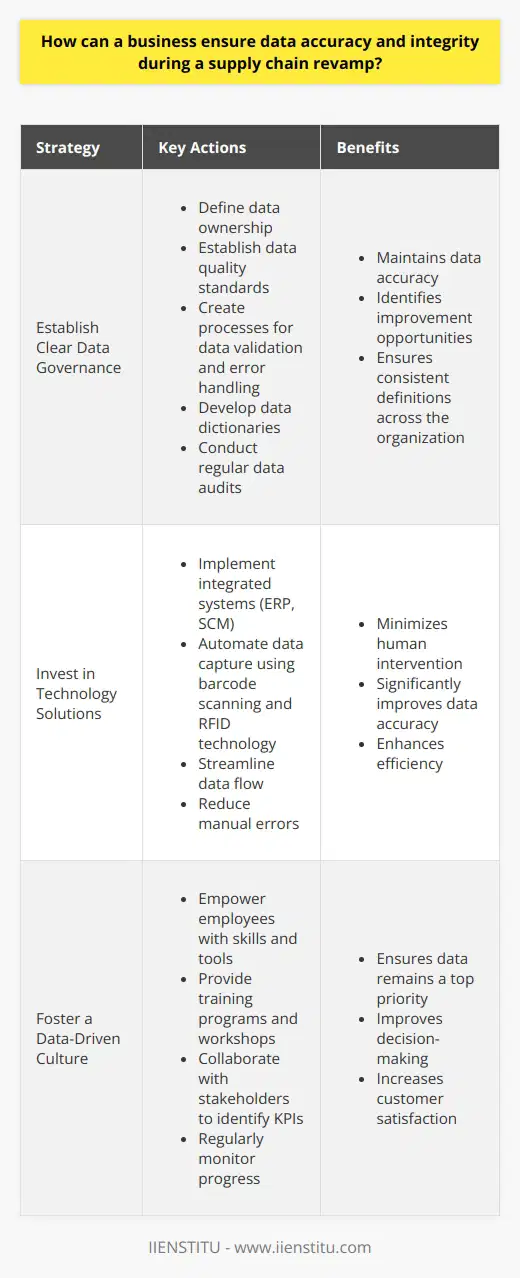
What are the main obstacles in achieving supply chain visibility during a redesign?
Achieving supply chain visibility during a redesign can be challenging. I've encountered several obstacles in my experience:
Lack of Data Integration
Different systems and departments often use their own data formats. This makes it difficult to get a unified view. I remember struggling to consolidate data from various sources in one project.
Incomplete or Inaccurate Data
Missing or incorrect data is a common issue. Suppliers may provide outdated information or fail to report changes promptly. Manual data entry can also introduce errors.
Example:
In a past redesign, we discovered that inventory levels were misreported due to human error in data entry.
Resistance to Change
Implementing new processes and technologies for visibility can face resistance. People may be hesitant to adopt new systems. Overcoming this requires clear communication and change management.
Technical Limitations
Existing IT systems may have limitations that hinder visibility. Legacy systems might not integrate well with new solutions. Upgrading technology can be costly and time-consuming.
Despite the challenges, I believe achieving supply chain visibility is crucial. It enables better decision-making and agility. With the right strategies and tools, these obstacles can be overcome.
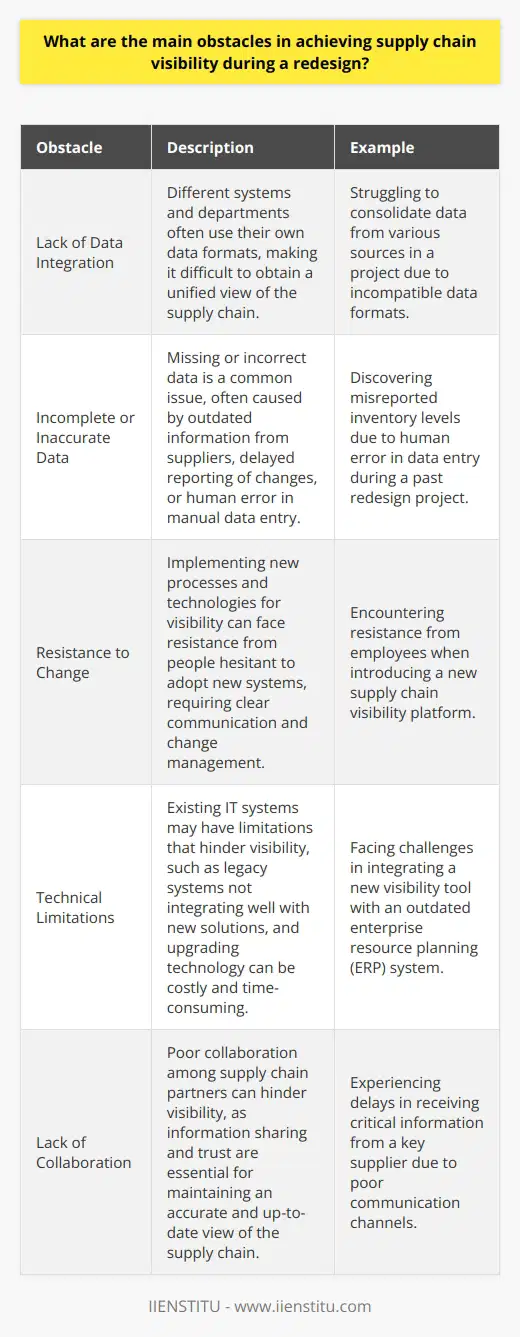
How can an organization build resilience into a redesigned supply chain?
When I was working as a supply chain analyst at Acme Corporation, we faced significant disruptions due to the COVID-19 pandemic. It became clear that our supply chain needed to be redesigned with resilience in mind. Based on that experience, here are some key ways I believe an organization can build resilience into a redesigned supply chain:<h3>Diversify Suppliers and Manufacturing Sites</h3><p>Having a diverse network of suppliers and manufacturing facilities in different geographic regions is crucial. That way, if disruption affects one area, you can shift to alternate sources. After COVID hit, we expanded our supplier base and established backup manufacturing capability in several countries.
Increase Inventory of Critical Components
For key components and materials that could cause production stoppages if unavailable, it's smart to increase inventory levels. We did a thorough analysis to identify critical materials and boosted our reserves of those items. It required investment but prevented shortages.
Improve Supply Chain Visibility with Technology
Leveraging cutting-edge supply chain management technology is essential for real-time visibility. Tools for demand sensing, inventory tracking, and predictive analytics really made a difference for us. With better data and AI-powered insights, we could sense disruptions earlier and react faster.
Conduct Regular Risk Assessments and Continuity Planning
Supply chain resilience has to be a proactive, ongoing effort, not a one-time fix. Frequent risk assessments are important to identify vulnerabilities. And you need robust business continuity plans that are regularly practiced. No one can anticipate every possibility, but resilient supply chains are ready to handle the unexpected.

What are the key challenges in managing inventory during a supply chain overhaul?
Managing inventory during a supply chain overhaul presents several key challenges that require careful planning and execution. In my experience, the most significant challenges include:
Accurately Forecasting Demand
Predicting customer demand becomes increasingly difficult when your supply chain is in flux. I've found that collaborating closely with sales and marketing teams helps improve forecast accuracy during these transitional periods.
Maintaining Optimal Stock Levels
Balancing the right amount of inventory is critical to avoid stockouts or overstocking. I recommend conducting frequent inventory audits and adjusting reorder points as needed to adapt to changing lead times and demand patterns.
Managing Supplier Relationships
Communication is key when working with suppliers during a supply chain overhaul. I've learned that being transparent about our needs and timelines helps foster trust and cooperation, ensuring a smooth transition.
Minimizing Disruptions to Operations
Implementing new processes and systems can temporarily disrupt inventory management. To mitigate this, I suggest phasing in changes gradually and providing thorough training to team members to minimize errors and delays.
Monitoring Performance Metrics
Tracking key performance indicators such as inventory turnover and fill rates is essential to gauge the success of your inventory management during the overhaul. I've found that setting clear benchmarks and regularly reviewing progress helps identify areas for improvement.
While managing inventory during a supply chain overhaul can be challenging, I believe that with proactive planning, effective communication, and a willingness to adapt, it's possible to successfully navigate these changes and emerge with a more efficient and resilient inventory management system.
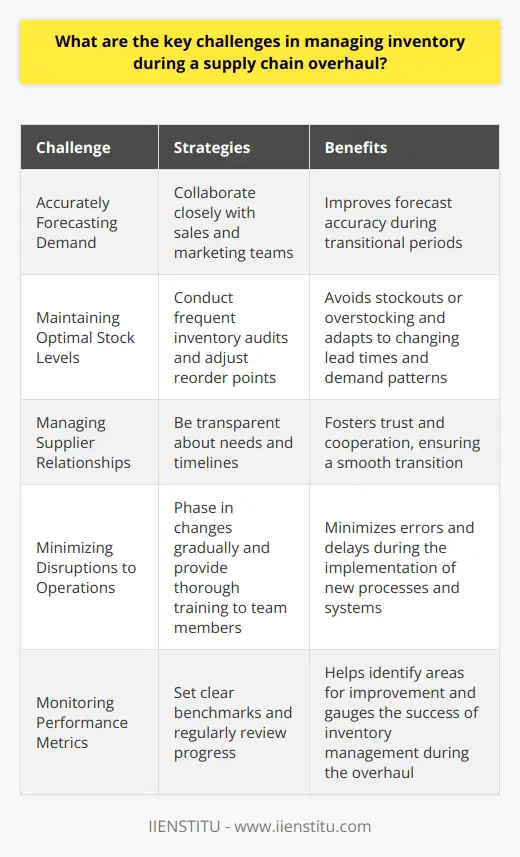
How can a company maintain supplier relationships during a supply chain restructuring?
Maintaining supplier relationships during a supply chain restructuring is crucial for a company's success. Open communication is key. I always make sure to keep suppliers informed about changes and involve them in the process. This helps build trust and understanding.
Collaborate on Solutions
When issues arise, I work with suppliers to find mutually beneficial solutions. Brainstorming together generates creative ideas that meet everyone's needs. Approaching challenges as a team strengthens the partnership.
Emphasize Long-Term Benefits
While restructuring can cause short-term disruptions, I highlight the long-term advantages for suppliers. Streamlined processes, increased efficiency, and growth opportunities are all selling points. When suppliers understand the vision, they're more likely to stay on board.
Provide Support and Resources
I believe in offering support to help suppliers navigate the transition. This could mean providing training, technology, or temporary financial assistance. Investing in their success pays off in loyalty and reliability.
Celebrate Milestones and Successes
Restructuring is a journey, and it's important to acknowledge progress along the way. I make a point to celebrate milestones reached with suppliers. Recognizing their hard work and contributions to the company's success strengthens the relationship for the future.
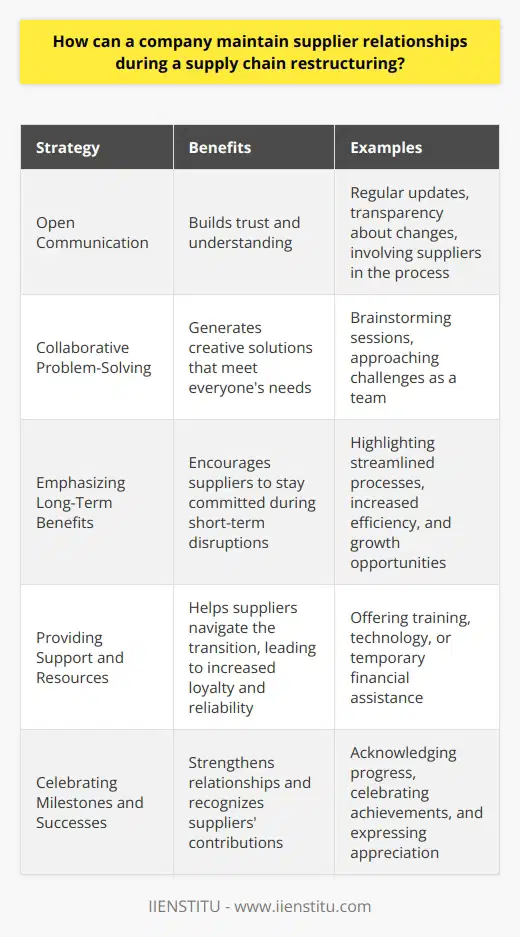
What are the primary hurdles in optimizing transportation and logistics in a redesigned supply chain?
Optimizing transportation and logistics in a redesigned supply chain can be challenging. In my experience, the primary hurdles include:
Integration of Systems
Integrating various transportation and logistics systems can be a significant challenge. Each stakeholder may use different technologies and processes, making it difficult to create a seamless flow of information and goods.
Collaboration and Communication
Effective collaboration and communication among supply chain partners are crucial. I've found that without clear lines of communication, it's hard to coordinate efforts and resolve issues quickly.
Infrastructure Limitations
Existing infrastructure, such as roads, ports, and warehouses, may not be adequate to support the redesigned supply chain. Upgrading infrastructure can be costly and time-consuming.
Regulatory Compliance
Complying with various regulations, such as customs, safety, and environmental laws, can be complex. Navigating these regulations requires expertise and can slow down the optimization process.
Demand Forecasting
Accurately forecasting demand is essential for optimizing transportation and logistics. However, it can be challenging, especially in dynamic markets with fluctuating consumer preferences.
Risk Management
Identifying and mitigating risks, such as supply disruptions, natural disasters, and geopolitical events, is crucial. I believe having contingency plans in place can help minimize the impact of unforeseen events.
In conclusion, optimizing transportation and logistics in a redesigned supply chain requires a holistic approach. It involves addressing various challenges, from system integration to risk management, while fostering collaboration and communication among stakeholders.

How can a business ensure compliance with regulations during a supply chain transformation?
As a supply chain manager, I understand the importance of ensuring compliance with regulations during a transformation. One key strategy is to establish a dedicated compliance team that works closely with the transformation project team. This team should include experts in relevant regulations and be involved from the start.
Conduct Thorough Risk Assessments
Before implementing any changes, the compliance team should conduct comprehensive risk assessments. They need to identify potential regulatory risks and develop mitigation plans. Engaging with regulators early on can also provide valuable guidance and prevent surprises down the line.
Implement Robust Policies and Procedures
Based on the risk assessments, the compliance team should develop robust policies and procedures. These should be clearly documented and communicated to all stakeholders. Regular training sessions can help ensure everyone understands their roles and responsibilities in maintaining compliance.
Leverage Technology for Compliance Monitoring
In my experience, technology can be a powerful tool for compliance monitoring. Implementing systems that provide real-time visibility into the supply chain can help identify potential issues early. Automated alerts can notify the compliance team of any deviations from established policies and procedures.
Foster a Culture of Compliance
Ultimately, ensuring compliance during a supply chain transformation requires a strong culture of compliance. Leadership must set the tone from the top and emphasize the importance of regulatory adherence. Encouraging open communication and reporting of potential issues can help identify and address compliance risks proactively.
By following these strategies, businesses can navigate the complexities of regulatory compliance during a supply chain transformation. It requires a collaborative effort between the transformation project team and a dedicated compliance team. With careful planning, robust policies, and a commitment to compliance, businesses can successfully transform their supply chains while mitigating regulatory risks.
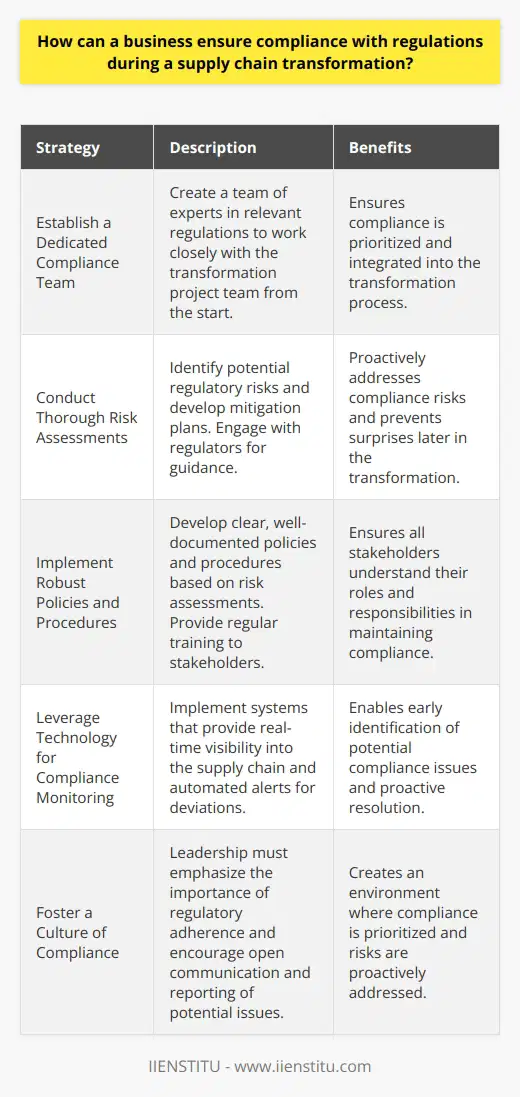
What are the main challenges in managing workforce changes during a supply chain redesign?
Managing workforce changes during a supply chain redesign presents several challenges. I've personally experienced the difficulty of maintaining employee morale and engagement during times of transition. It's crucial to communicate clearly and frequently with your team, addressing their concerns and involving them in the process.
Aligning Workforce with New Supply Chain Strategy
One of the biggest hurdles is ensuring your workforce understands and aligns with the new supply chain strategy. This requires comprehensive training and education programs to equip employees with the necessary skills and knowledge. In my experience, hands-on workshops and interactive sessions are most effective for facilitating this alignment.
Managing Resistance to Change
Another challenge is managing resistance to change within the workforce. People often fear the unknown and may be hesitant to embrace new processes or technologies. As a leader, it's important to listen to their concerns, empathize with their perspectives, and provide support throughout the transition. I've found that celebrating small wins and recognizing individual contributions can help build momentum and enthusiasm for the changes.
Maintaining Productivity During Transition
Maintaining productivity levels during the transition period is also a significant challenge. Disruptions to established workflows and learning curves for new systems can temporarily impact efficiency. To mitigate this, I recommend implementing a phased approach to the redesign, allowing time for employees to adapt and adjust. Providing ample resources, such as user guides, mentors, and help desks, can also smooth the transition.
Retaining Top Talent
Finally, retaining top talent during a supply chain redesign can be difficult, as uncertainty may prompt some employees to seek opportunities elsewhere. To combat this, it's crucial to regularly engage with your team, reinforcing their value to the organization and providing clear growth and development pathways within the new structure. Personally, I've found that transparent communication and involving key team members in decision-making processes foster a sense of ownership and loyalty.
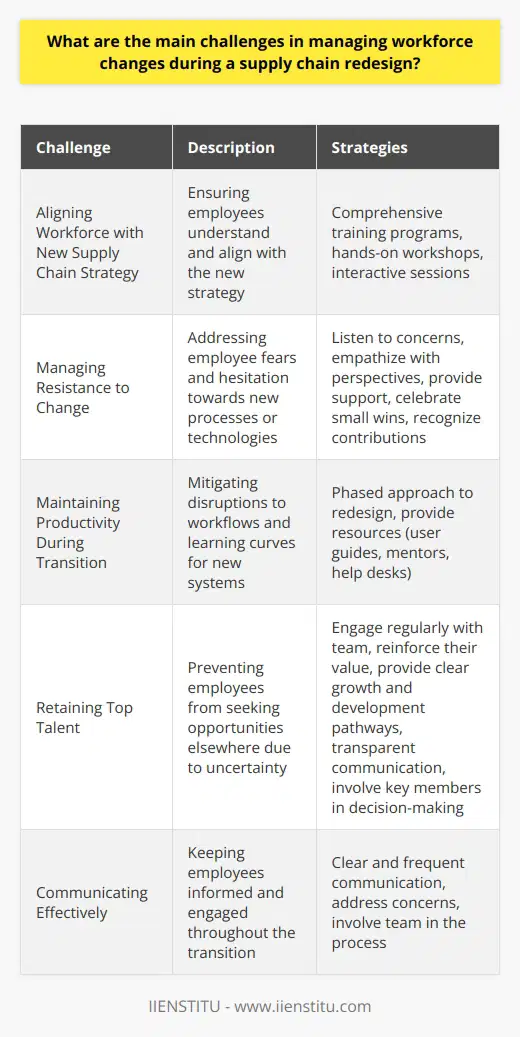
How can an organization effectively measure the success of a supply chain overhaul?
When an organization overhauls its supply chain, measuring success is crucial. I remember when our company went through a similar process last year. It was a challenging time, but we learned a lot about what works and what doesn't.
Key Performance Indicators (KPIs)
First and foremost, establish clear KPIs that align with your goals. These might include metrics like:
Choose KPIs that are meaningful to your specific industry and supply chain objectives. Don't overwhelm yourself with too many - focus on the most impactful ones.
Benchmarking and Tracking Progress
Before implementing changes, benchmark your current performance. This gives you a baseline to measure against as you move forward. Regularly track progress on your KPIs using dashboards and reports. Celebrate milestones along the way to keep everyone motivated!
Stakeholder Feedback
Don't forget about qualitative feedback from stakeholders. Suppliers, customers, and employees can provide valuable insights you might miss just looking at numbers. Their perspective helps paint a more complete picture of success.
Continuous Improvement
Supply chain optimization is an ongoing journey, not a one-time event. Embrace a continuous improvement mindset. Regularly review your metrics, gather feedback, and adapt as needed. The most successful overhauls are iterative and flexible.
Measuring success takes effort, but it's worth it. When done right, it keeps your supply chain agile and competitive in the long run. That's been my experience, at least. Let me know if you have any other questions!
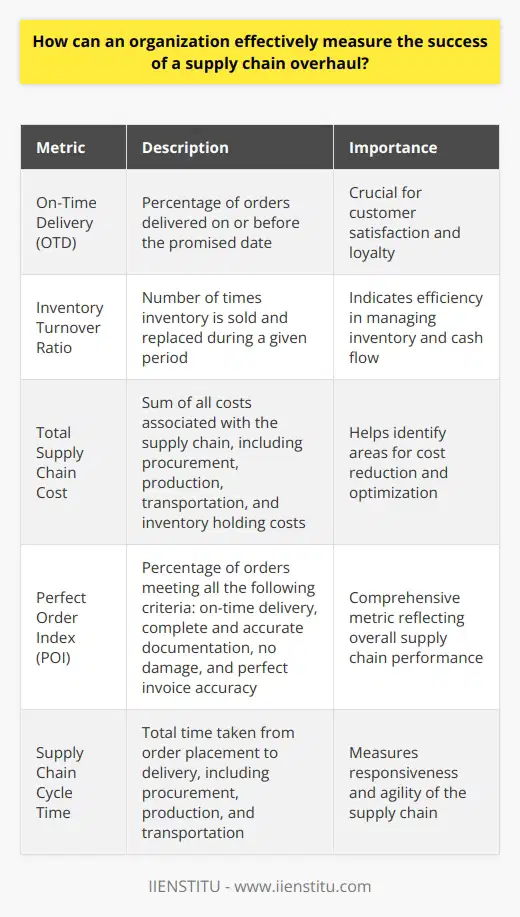
What are the key obstacles in scaling a redesigned supply chain?
As a supply chain professional, I've encountered several key obstacles when scaling a redesigned supply chain. One of the biggest challenges is aligning all stakeholders involved in the process.
Aligning Stakeholders
Getting everyone on the same page, from suppliers to logistics partners to internal teams, can be a daunting task. Communication and collaboration are crucial to ensure a smooth transition.
Overcoming Resistance to Change
Another obstacle is overcoming resistance to change within the organization. People are often comfortable with the status quo and may be hesitant to embrace new processes and technologies.
I remember when we implemented a new inventory management system at my previous company. It took time and effort to train employees and get them to adopt the new way of working.
Managing Increased Complexity
Scaling a redesigned supply chain also means managing increased complexity. As the network grows, so do the number of moving parts and potential points of failure.
Maintaining Visibility and Control
Maintaining visibility and control over the entire supply chain becomes more challenging as it scales. Robust data analytics and real-time monitoring are essential to identify and address issues promptly.
Ensuring Scalability and Flexibility
Finally, ensuring that the redesigned supply chain is scalable and flexible enough to accommodate future growth is crucial. This requires careful planning and investment in the right infrastructure and technologies.
In my experience, addressing these obstacles requires a combination of strategic thinking, effective communication, and a willingness to adapt and iterate as needed. It's not always easy, but the payoff can be significant in terms of increased efficiency, cost savings, and customer satisfaction.

How can a company mitigate the financial risks associated with supply chain restructuring?
To mitigate financial risks from supply chain restructuring, companies can take several proactive steps. First, they should thoroughly assess potential risks and develop contingency plans. This includes identifying alternative suppliers, transportation routes, and inventory management strategies.
Diversify Supplier Base
One key approach is diversifying the supplier base. By sourcing from multiple vendors in different locations, companies can reduce their vulnerability to disruptions. If one supplier experiences issues, others can help fill the gap.
Build Strong Supplier Relationships
Building strong, collaborative relationships with suppliers is also crucial. Open communication and trust allow for more flexibility and responsiveness when challenges arise. I've seen firsthand how solid partnerships can make navigating supply chain changes much smoother.
Implement Risk Monitoring Systems
Companies should also implement robust risk monitoring systems. These provide real-time visibility into the supply chain, enabling quick detection and response to potential issues. Advanced analytics can even help predict and prevent problems before they occur.
Maintain Adequate Financial Reserves
Maintaining adequate financial reserves is another important safeguard. Having a cushion of cash or credit can help absorb unexpected costs and keep operations running smoothly during transitions. It's saved my company more than once!
Foster a Culture of Agility
Finally, fostering a culture of agility is essential. Encourage creativity, problem-solving, and adaptability at all levels of the organization. Empower teams to make quick decisions when faced with supply chain disruptions. The most resilient companies I've worked with embrace change and think on their feet.
By taking these proactive measures, companies can significantly reduce the financial risks of supply chain restructuring. It takes effort and resources, but the peace of mind is more than worth it.
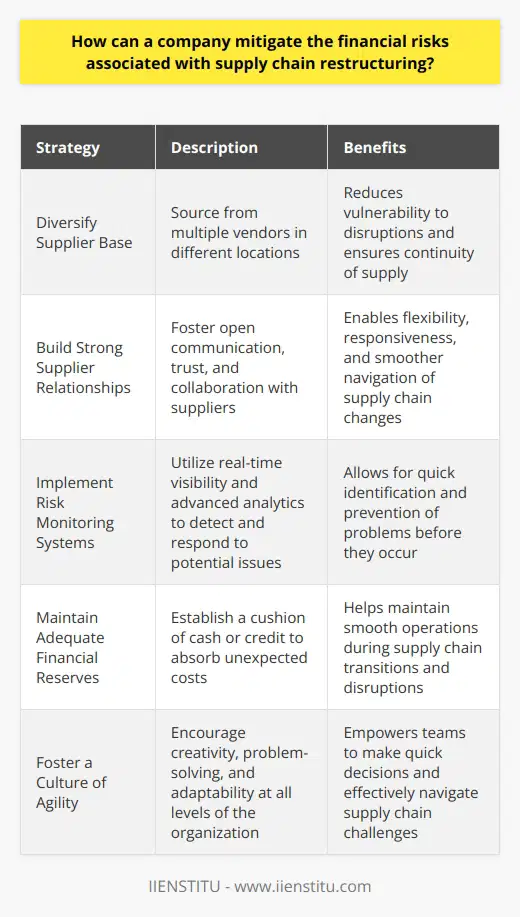
What are the primary challenges in ensuring data security during a supply chain revamp?
Data security is a critical concern during a supply chain revamp. One of the primary challenges is ensuring that sensitive information remains protected throughout the process.
Identifying Vulnerabilities
It's essential to identify potential vulnerabilities in the new supply chain system. This includes assessing the security of new vendors, technologies, and processes. Conducting thorough risk assessments can help pinpoint areas that need extra attention.
Implementing Robust Security Measures
Once vulnerabilities have been identified, robust security measures must be put in place. This might include encrypting sensitive data, implementing strict access controls, and regularly monitoring for suspicious activity. It's crucial to work closely with IT security experts to develop a comprehensive security plan.
Training Employees
Another significant challenge is ensuring that all employees are properly trained on data security best practices. This is especially important during a supply chain revamp when new systems and processes are being introduced. Employees must understand their role in keeping data secure and know how to identify and report potential security threats.
Staying Vigilant
Even with robust security measures in place, it's essential to remain vigilant. Regularly reviewing and updating security protocols can help ensure that data remains protected over time. It's also important to stay up-to-date on the latest security threats and best practices in the industry.
Ensuring data security during a supply chain revamp is a complex and ongoing process. By identifying vulnerabilities, implementing strong security measures, training employees, and staying vigilant, companies can help protect sensitive information and maintain the integrity of their supply chain.
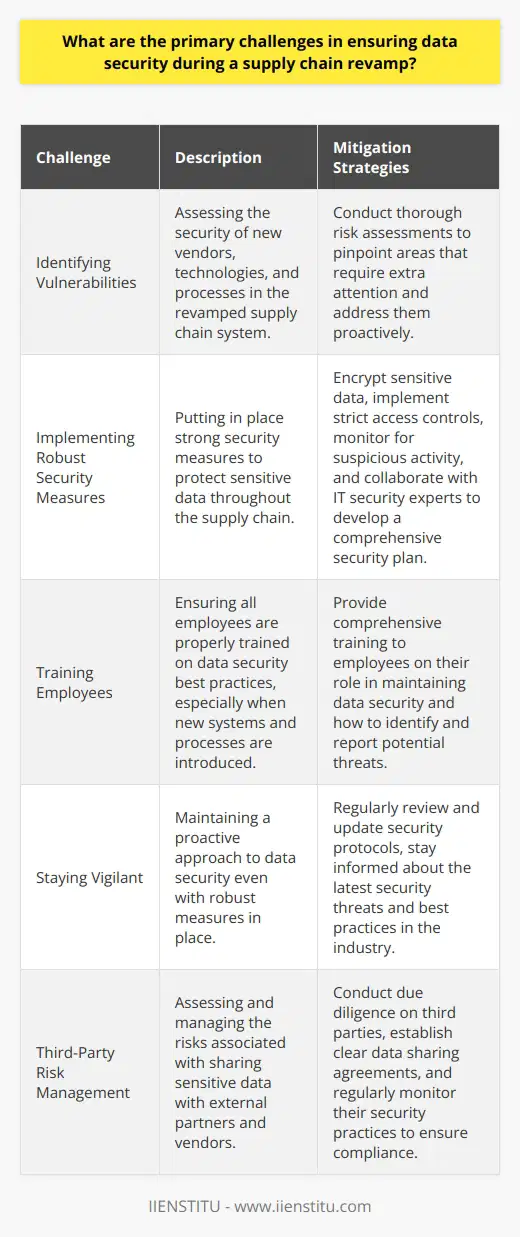
How can a business maintain customer satisfaction during a supply chain redesign?
Maintaining customer satisfaction during a supply chain redesign requires a proactive approach. Here are some strategies I recommend:
Communicate openly with customers
Keep your customers informed about the changes you're making and how they may be affected. Be transparent and honest in your communication. Set realistic expectations about potential disruptions or delays.
Focus on customer needs
Throughout the redesign process, always keep the customer's perspective in mind. What do they value most - speed, quality, price? Prioritize changes that will have the greatest positive impact on their experience.
Example from my experience:
In my previous role, we underwent a major supply chain overhaul. I made sure to regularly touch base with our key accounts. By understanding their priorities, we were able to implement changes with minimal disruption to their orders. Open communication was essential.
Maintain inventory levels
If possible, build up extra inventory before beginning the redesign. This will help prevent stockouts and backorders during the transition. Work closely with suppliers to ensure a steady flow of goods.
Have contingency plans
No matter how well you plan, unexpected issues can arise. Develop backup plans for various scenarios. Think about alternative suppliers, expedited shipping options, and how to handle customer complaints. Being prepared will help you respond quickly if problems occur.
By being proactive, communicative, and customer-focused during a supply chain redesign, you can maintain high levels of customer satisfaction. It takes effort, but it's worth it to preserve those valuable relationships.
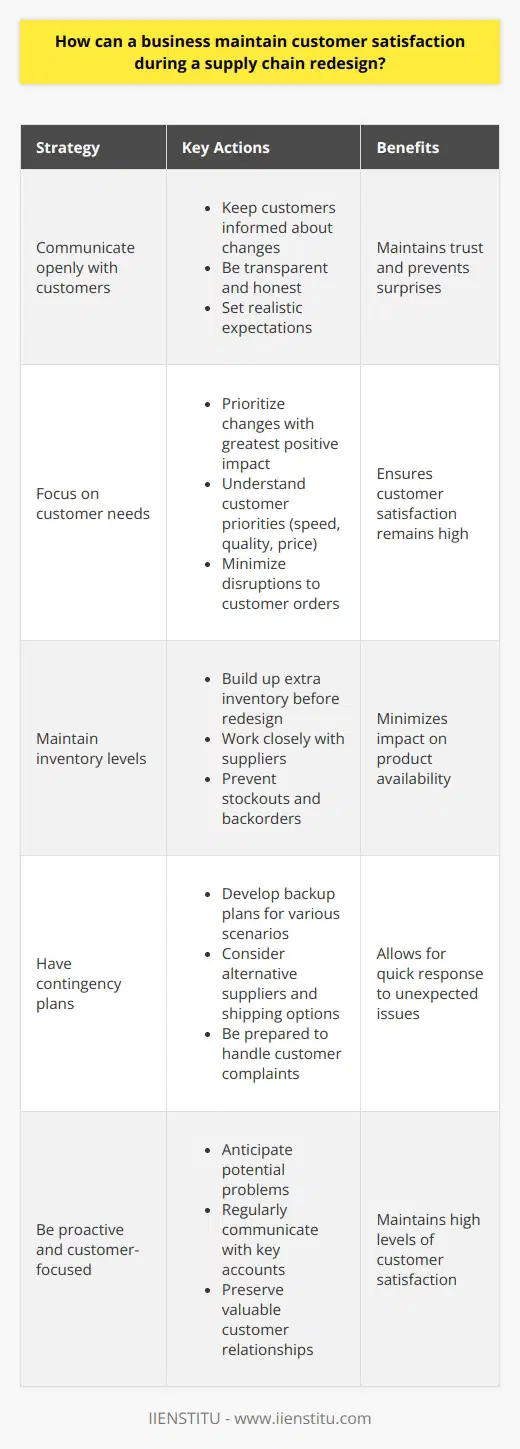
What are the main hurdles in achieving end-to-end supply chain collaboration during a transformation?
Achieving end-to-end supply chain collaboration during a transformation can be challenging. In my experience, there are several key hurdles that companies often face:
Aligning Goals and Incentives
One of the biggest challenges is getting everyone on the same page. Each department and stakeholder may have their own priorities and metrics. It's crucial to align these goals and create shared incentives that encourage collaboration and a focus on the greater good of the supply chain.
Breaking Down Silos
Many organizations operate in silos, with limited communication and data sharing between departments. Breaking down these barriers is essential for effective collaboration. It requires a shift in mindset and the implementation of processes and technologies that enable seamless information flow.
Change Management
Transforming the supply chain often involves significant changes to processes, roles, and technologies. Managing this change effectively is critical. It requires clear communication, training, and support to help employees adapt and embrace new ways of working.
Technology Integration
Integrating disparate systems and technologies across the supply chain can be a major hurdle. It's important to have a clear technology roadmap and to invest in solutions that enable real-time data visibility and collaboration.
Building Trust and Transparency
Collaboration requires trust and transparency among all parties involved. Building strong relationships, establishing clear communication channels, and creating a culture of openness and honesty are key to overcoming this hurdle.
While these challenges may seem daunting, I've seen firsthand how companies can overcome them with the right approach and mindset. By focusing on alignment, breaking down silos, managing change effectively, integrating technology, and building trust, organizations can achieve true end-to-end supply chain collaboration and reap the benefits of a more agile, responsive, and efficient supply chain.
